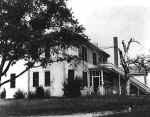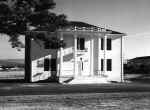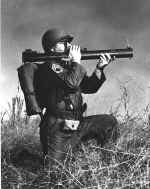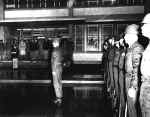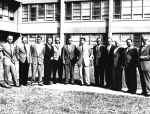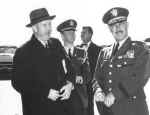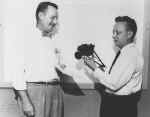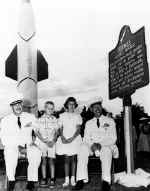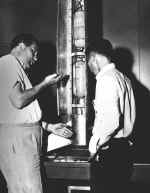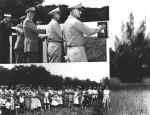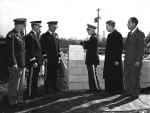1956
|
1956 The 259th CORPORAL Battalion was replaced in Europe by units equipped with CORPORAL Type II systems. |
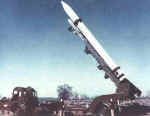
|
|
1956 The M31A1C rocket, a retest rocket which qualified the Basic HONEST JOHN for firing at extended temperature limits, was designated as a standard military item and placed in production. |
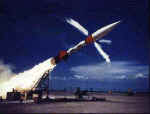
|
|
January 56 The LITTLEJOHN project was reoriented into two phases: an interim and optimum system. Formal development of the interim system began. |

|
|
January 56
A two-story farm house built over 100 years earlier, acquired by the Army in 1941 when it purchased
the Huntsville Arsenal reservation, was moved across Redstone Arsenal to a site adjacent to the
headquarters building. After renovations were completed during
this month, the building was released for "beneficial occupancy" on 1 February. It served
as the arsenal's guest house for top-ranking official visitors. On 1 May 56, it was officially named
the "Goddard House" in honor of Robert H. Goddard, the man considered to be the "father"
of American rocketry.
|
||
|
|
1 January 56 Redstone Arsenal acquired 65.2 acres consisting of the Redstone Park housing project at Farley, Alabama, for a total cost of $8,911.50. |
|
|
6 January 56 The Department of Defense (DOD) approved the construction of another 120 Capehart housing units at Redstone Arsenal. |
|
19 January 56 The Chief of Ordnance issued an order assigning ABMA responsibility for the REDSTONE missile and Intermediate Range Ballistic Missile (IRBM) programs. |
|
|
4 February 56 DOD approved the construction of an additional 150 housing units at Redstone Arsenal under the Capehart Section of the Housing Act. 9 February 56 The 283d Ordnance Detachment (Technical Intelligence) was assigned to Redstone Arsenal. It was attached to OML for operational control. 15 February 56 The Redstone Arsenal Air Strip was turned over to ABMA for operation and physical security, as formally requested by the ABMA Commander. 17 February 56 Responsibility for physical security and control of all facilities within the fenced area on Ward Mountain (commonly referred to as "Squirrel Hill") was transferred to ABMA, at the ABMA Commander's request. 20 February 56 The Department of the Army (DA) released the first photographs showing the REDSTONE missile in flight and undergoing static tests. 22 February 56 Sperry Gyroscope Company was selected as the research and development (R&D) co-contractor for the SERGEANT project. It joined the program initiated by the Army's Jet Propulsion Laboratory (JPL) in June 56. The company eventually became the project's prime industrial contractor. March 56 Following ABMA's establishment, there was a steady influx into Huntsville of new personnel seeking family housing. Both the Redstone Billeting Office and the Huntsville Chamber of Commerce were swamped with requests for housing. During this month, both Redstone Arsenal and ABMA employees were assigned to work full-time at the Chamber of Commerce to assist that organization in locating rental units for arsenal personnel. March 56 Redstone Arsenal sold 248 acres located between Highway 20 and the Southern Railroad to the Huntsville Industrial Expansion Committee for $52,576.01. 6 March 56 The Chief of Ordnance granted authority to the RSA Commander, at the latter's request, to transport dependent school children to and from Huntsville public schools. This action was prompted by the overcrowded and generally unsatisfactory conditions of the local commercial bus facilities, which had been declared inadequate to meet the arsenal's needs. 12 March 56 The Joint Army-Navy Ballistic Missile Committee approved the solid propellant IRBM program under the cognizance of the U.S. Navy. 12 March 56 The arsenal infirmary was upgraded to become the U.S. Army Hospital, Redstone Arsenal. 14 March 56 JUPITER A Missile 18, an adapted REDSTONE, was the first missile launched from Cape Canaveral, Florida, following ABMA's activation. 14 March 56 The Secretary of the Army announced that the first REDSTONE missile battalion would be formed at RSA on 15 April 56. 17 March 56 The Chief of Ordnance approved plans to move loading facilities from Redstone Arsenal to the Lone Star Ordnance Plant, Texas. 19 March 56 BG Holger N. Toftoy, along with other arsenal and city officials, met with Governor James E. Folsom, Sr. to request that the state legislature remain in session 5 more days to consider the housing situation in Huntsville. The request was granted, and a bill to expand the city's limits was passed. April 56 A special census revealed that by this date the population of Huntsville had jumped from 16, 437 in the 1950 census to over 50,000. This rapid increase caused serious housing problems for the city. 4 April 56 The Secretary of Defense authorized the Navy to proceed with system studies and component development, including propulsion flight testing needed to determine weapon system feasibility of a solid propellant version of the IRBM. Also during this month, the IRBM-2, as the latter system was known, was designated JUPITER. The IRBM-1, a U.S. Air Force (USAF) project, was named THOR. 12 April 56 Huntsville city officials reached an agreement with ABMA representatives to establish a control tower at the Redstone Army Airfield to handle both military and commercial air traffic pending the establishment of facilities at the Huntsville City Airport. Facilities at the Army airfield approved by the Civil Aeronautics Authority (CAA) were needed to help clear the way for commercial aircraft to enter Huntsville on an established airway. 12 April 56 The Joint Army-Navy Ballistic Missile Committee assigned the Army as lead for the radio-controlled guidance program on the JUPITER missile. 15 April 56 The first REDSTONE missile battalion--the 217th Field Artillery Missile Battalion--was formally activated at RSA. The unit was assigned to the Third Army and attached to ABMA. 23 April 56 The Army informed the Office of the Secretary of Defense (OSD) that a JUPITER missile could be fired in an effort to orbit a small satellite in January 57. 26 April 56 The CAA agreed to establish an airway from Muscle Shoals, Alabama, through Huntsville to Chattanooga, Tennessee. It also agreed to control traffic in the Huntsville area from Memphis through a proposed tower at Redstone Army Airfield pending the establishment of a permanent facility at the Huntsville City Airport. 26 April 56 The Secretary of Defense approved the building of 400 additional Capehart housing units for military personnel at Redstone Arsenal. As a result, the number of units to be constructed on post under this act totaled 670. 8 May 56 Members of the Plumbers and Steamfitters Union picketed the main gates of Redstone Arsenal in an effort to force the Empire Gas Engineering Company, a construction contractor, to reinstate its working agreement with the union. This labor dispute forced an almost complete shutdown of arsenal construction work for a week, delaying several high priority projects. 11 May 56 An RSA Public Education Liaison Committee was established to deal with city, county, and state education agencies on matters pertaining to the public education of children of military and civilian personnel living on post. 15 May 56 The OSD's Special Assistant for Guided Missiles disapproved ABMA's request that the JUPITER C reentry test vehicle be used as an alternate to the VANGUARD vehicle. 19 May 56 The REDSTONE missile was displayed publicly for the first time in an Armed Forces Day exhibit at Selfridge Air Force Base (AFB) in Detroit, Michigan. 22 May 56 ABMA was informed of a decision by the Office of the Assistant Secretary of Defense that no plans or preparations should be initiated for using JUPITER or REDSTONE missiles as launch vehicles for orbiting a satellite. |
|
June 56 The first guided HAWK missile hit the nose of an F-80 drone flying at 11,000 feet and demolished it in a shower of flaming fragments. |

|
|
June 56 The first LACROSSE I production prototype missile was delivered. |

|
|
14 June 56 The REDSTONE missile went on public display in the Huntsville area for the first time during the celebration of the Army's 181st anniversary. It was exhibited in the OGMS area of the arsenal, along with the Army's other large systems: CORPORAL, NIKE, and HONEST JOHN. 27 June 56 Bids were opened for the construction of 270 Capehart housing units to be located west of the Wherry Housing Project on Goss Road. Construction work on the initial phase of the Capehart program began in August 56. 30 June 56 RSA was relieved of its mission producing chemical ammunition, except for the completion of current work schedules assigned by the Ordnance Ammunition Command (OAC). That same day, the arsenal's oldest mission activity--the Ammunition Division--was abolished after 14 years of operation. Responsibility for performing the division's remaining functions was transferred to the Redstone Depot. |
|
July to December 56 Environmental tests of the "Small Fry," the world's smallest rocket, were completed during this period. |
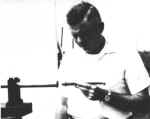
|
|
2 July 56 MG John B. Medaris, the ABMA Commander, officially opened the renovated Redstone Army Airfield as a passenger in the first plane to land at the improved field. As it landed, the plane's propeller cut a ribbon stretched across the airstrip. The ribbon cutting for the airfield's control tower was accomplished with a conventional pair of scissors.
|
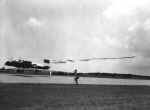
|
|
19 July 56 The first REDSTONE missile to be fabricated and assembled by Chrysler was flight tested. |
|
26 July 56 The ground breaking ceremony for the new Post Chapel was held. |

|
|
26 July 56 Redstone Depot became responsible for operating a guided missile ammunition evaluation and procedures shop for ABMA missile systems. It also served as a stock management and accounting system for all Army ballistic missile materiel, providing availability and condition data on a worldwide basis. In addition, the depot furnished a single source of worldwide supply by receiving, storing, maintaining in storage, and issuing all Army ballistic missile materiel. |
|
8 August 56 Construction of the largest static test stand in the United States for testing rocket motors was completed at RSA. It was slated for use in the JUPITER program. |
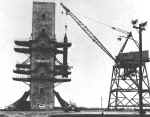
|
|
8 August 56 JUPITER A Missile RS-20 was successfully launched. This was the first time that combustion chamber pressure was controlled. |
|
September 56 Army Ordnance chose a modification of Sylvania's proposed design for development of the PLATO guided antimissile missile. |
|
September 56 The first industrial contract for the DART was negotiated. |
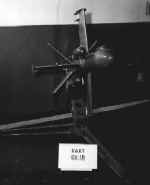
|
|
20 September 56 BG Holger N. Toftoy was promoted to major general. |
|
20 September 56 Construction was started on 270 Capehart housing units at RSA. This was the second of a three-phase construction program encompassing 720 military family housing units. |

|
|
October 56 Raytheon Manufacturing Company became sole source production contractor for the HAWK system during this month. 6 October 56 The LITTLEJOHN rocket, designed and developed at RSA, was unveiled for its first public showing at Aberdeen Proving Ground (APG), Maryland, during the thirty-eighth annual meeting of the American Ordnance Association. |
|
1 November 56 DA authorized the Chief of Ordnance to begin phased development of the NIKE II system. |

|
|
15 November 56 The NIKE I was redesignated NIKE AJAX effective this date. In addition, the NIKE B was renamed NIKE HERCULES, while the NIKE II was renamed NIKE ZEUS. 18 November 56 The cornerstone for the new Post Chapel was laid during a brief ceremony. 26 November 56 The Secretary of Defense issued a memorandum to the Armed Forces Policy Council fixing the missile development roles of the three Armed Services. The Air Force was given operational jurisdiction over long-range missiles; the Army was made responsible for missiles up to 200 miles and for "point defense;" and the Navy was given control of ship-based missiles. These new roles were announced on 28 November. 8 December 56 The Secretary of Defense approved the Navy solid propellant ballistic missile program which authorized the Navy to cancel all participation in the liquid-propelled JUPITER IRBM program. The Navy substituted its POLARIS IRBM for the previously approved JUPITER solid propellant motor program. 18 December 56 The Joint Army-Navy Ballistic Missile Committee was formally disestablished. Late 56 - Early 57 Because of the REDSTONE's proven reliability, DOD and the Armed Forces Special Weapons Project chose the missile to participate in Operation Hardtack, a study of the effects of nuclear detonation at high altitudes. |
The ABMA/AOMC Era: Introduction, 1956, 1957, 1958, 1959, 1960, 1961, 1962

